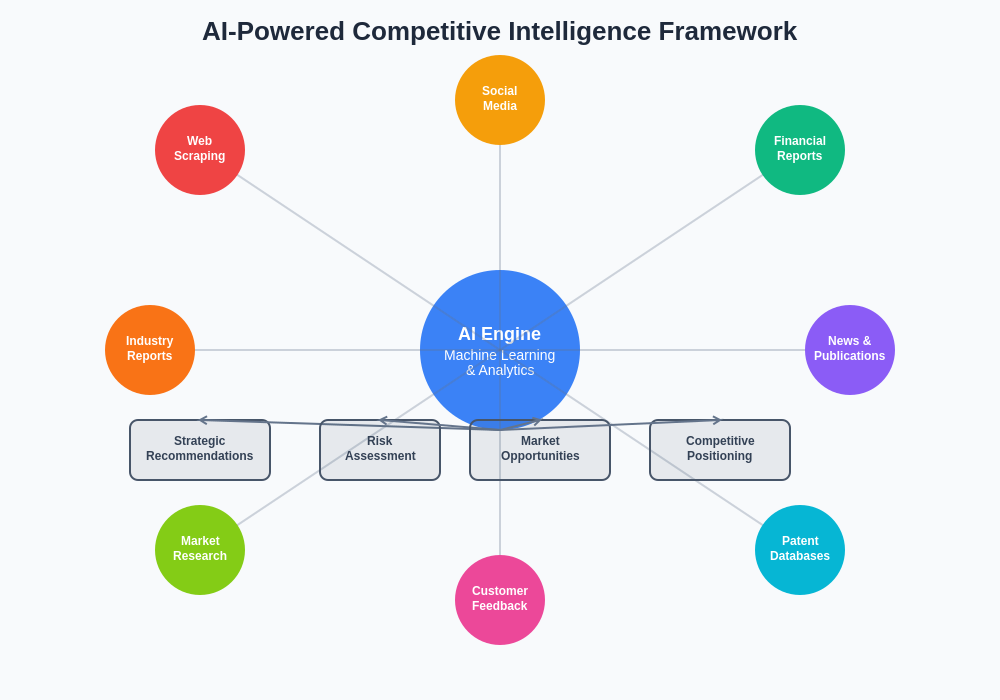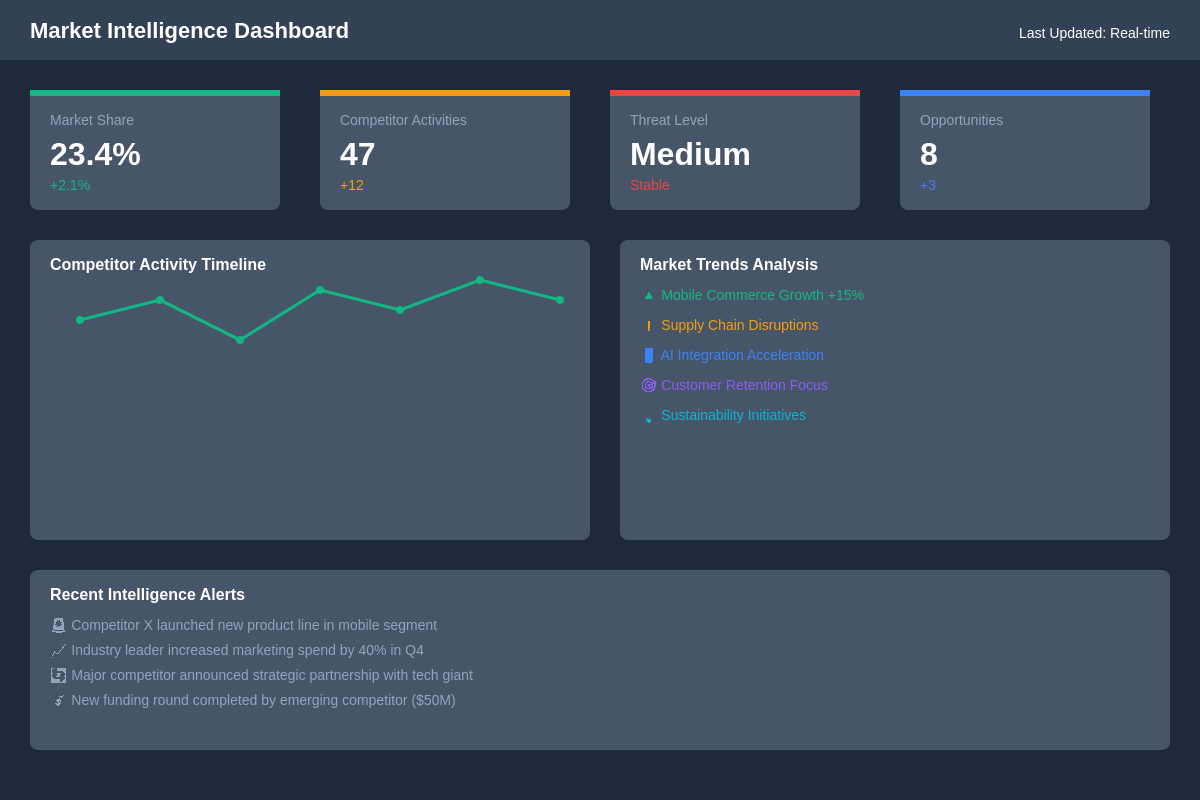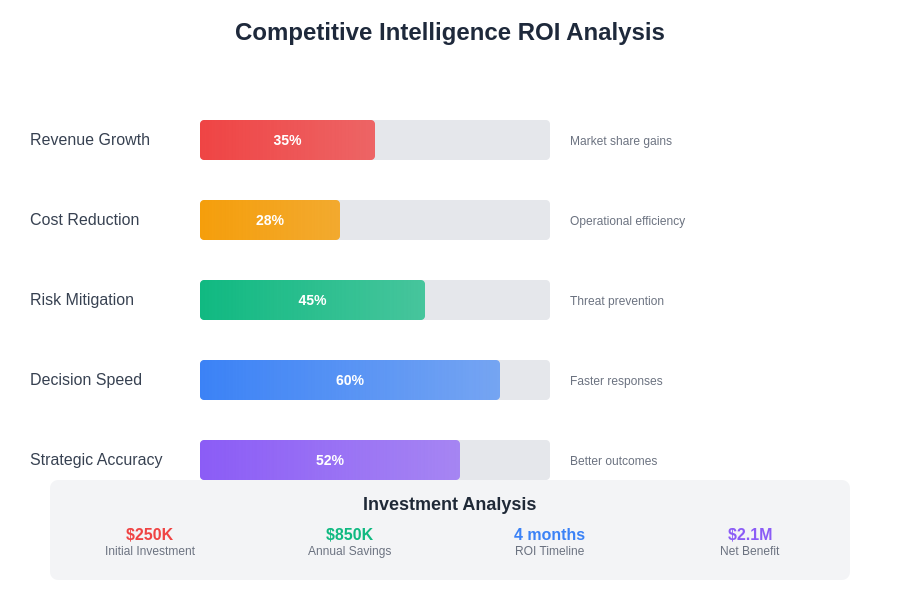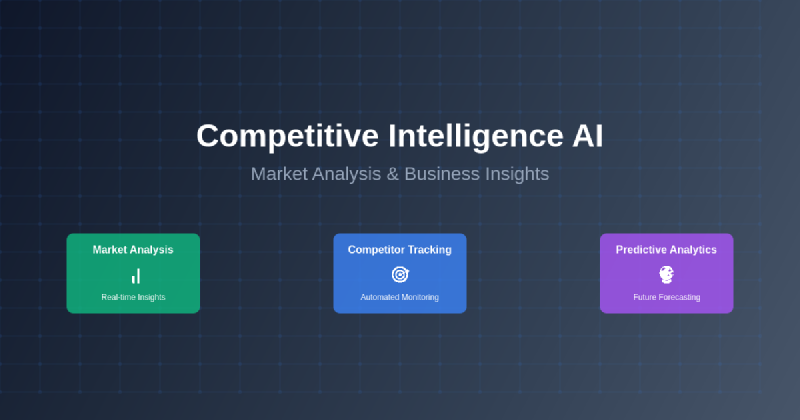The business landscape has evolved into an increasingly complex and fast-paced environment where organizations must constantly monitor their competitive environment to maintain strategic advantage. Artificial intelligence has emerged as a transformative force in competitive intelligence, revolutionizing how companies gather, analyze, and act upon market data to make informed strategic decisions. This technological evolution has shifted competitive intelligence from a reactive, manual process to a proactive, automated system that provides real-time insights and predictive analytics that drive business success.
Stay updated with the latest AI trends in business intelligence to understand how cutting-edge technologies are reshaping competitive analysis and market research methodologies. The integration of artificial intelligence into competitive intelligence represents a fundamental shift in how organizations understand their market position, competitor strategies, and emerging opportunities in an increasingly data-driven business environment.
The Evolution of Competitive Intelligence Through AI
Traditional competitive intelligence relied heavily on manual data collection, human analysis, and periodic reporting that often resulted in outdated insights by the time they reached decision-makers. The introduction of artificial intelligence has fundamentally transformed this paradigm by enabling continuous monitoring, real-time analysis, and predictive insights that help organizations stay ahead of market trends and competitor movements. Modern AI-powered competitive intelligence systems can process vast amounts of structured and unstructured data from multiple sources simultaneously, providing a comprehensive view of the competitive landscape that was previously impossible to achieve through manual methods.
The sophistication of AI-driven competitive intelligence extends beyond simple data aggregation to include advanced pattern recognition, sentiment analysis, and predictive modeling that can identify emerging trends, forecast competitor actions, and reveal hidden market opportunities. This technological advancement has democratized access to enterprise-level competitive intelligence capabilities, enabling organizations of all sizes to compete more effectively in their respective markets while making data-driven strategic decisions based on comprehensive market analysis.
Automated Data Collection and Market Monitoring
The foundation of effective competitive intelligence lies in comprehensive data collection from diverse sources including competitor websites, social media platforms, news publications, patent databases, financial reports, and industry publications. AI-powered systems have revolutionized this process by automatically monitoring thousands of sources simultaneously, extracting relevant information, and organizing it into actionable intelligence formats. Machine learning algorithms can identify and categorize competitive information, filtering out noise to focus on the most strategically relevant insights that impact business decision-making.
Advanced web scraping technologies combined with natural language processing enable these systems to understand context, identify key competitive moves, and alert organizations to significant changes in their competitive environment. The automation of data collection ensures that no critical information is overlooked while dramatically reducing the time and resources required to maintain comprehensive competitive awareness. This continuous monitoring capability provides organizations with the real-time intelligence necessary to respond quickly to competitive threats and capitalize on emerging market opportunities.
Enhance your business intelligence capabilities with Claude to leverage advanced AI reasoning for complex market analysis and strategic planning tasks. The combination of automated data collection and intelligent analysis creates a powerful competitive intelligence infrastructure that supports informed decision-making across all levels of the organization.
Advanced Analytics and Pattern Recognition
The true power of AI in competitive intelligence emerges through its ability to identify complex patterns and relationships within vast datasets that would be impossible for human analysts to detect manually. Machine learning algorithms can analyze competitor behavior patterns, market trends, pricing strategies, and customer sentiment to reveal insights that inform strategic planning and tactical execution. These systems can identify subtle correlations between seemingly unrelated data points, providing organizations with a deeper understanding of market dynamics and competitive relationships.
Predictive analytics capabilities enable organizations to anticipate competitor moves, forecast market trends, and identify potential disruptions before they fully materialize. By analyzing historical data patterns and current market conditions, AI systems can generate probability-based forecasts that help organizations prepare for various scenarios and develop contingency plans. This predictive capability transforms competitive intelligence from a reactive function to a proactive strategic tool that enables organizations to shape market conditions rather than merely respond to them.

The comprehensive framework for AI-powered competitive intelligence integrates multiple data sources, advanced analytics capabilities, and automated reporting systems to create a seamless intelligence operation that supports strategic decision-making at every level of the organization.
Real-Time Market Intelligence and Trend Analysis
The speed of modern business requires intelligence systems that can provide real-time insights rather than historical analysis that may no longer be relevant by the time it reaches decision-makers. AI-powered competitive intelligence platforms excel at processing streaming data from multiple sources simultaneously, providing organizations with up-to-the-minute insights about competitor activities, market conditions, and emerging trends. This real-time capability enables organizations to respond immediately to competitive threats, capitalize on market opportunities, and adjust strategies based on current market conditions.
Trend analysis capabilities powered by machine learning can identify emerging patterns in customer behavior, market demand, and competitive positioning that may not be apparent through traditional analysis methods. These systems can detect subtle shifts in market sentiment, identify emerging competitive threats, and highlight new opportunities that align with organizational capabilities and strategic objectives. The ability to identify trends as they emerge rather than after they have fully developed provides organizations with significant competitive advantages in rapidly changing markets.
Competitor Analysis and Strategic Positioning
Understanding competitor strategies, capabilities, and market positioning is essential for developing effective competitive strategies and maintaining market advantage. AI-powered systems can analyze competitor communications, product offerings, pricing strategies, and market positioning to provide comprehensive competitor profiles that inform strategic planning processes. These analyses can identify competitor strengths and weaknesses, reveal strategic intentions, and highlight opportunities for competitive differentiation.
Advanced sentiment analysis and communication monitoring can provide insights into competitor marketing strategies, customer relationships, and brand positioning that inform competitive response strategies. By analyzing competitor customer feedback, social media engagement, and market communications, organizations can identify opportunities to capture market share, improve their own offerings, and develop more effective competitive strategies. This comprehensive competitor analysis capability enables organizations to compete more effectively by understanding the competitive landscape and positioning themselves advantageously within their markets.
Market Opportunity Identification and Assessment
One of the most valuable applications of AI in competitive intelligence is its ability to identify and assess market opportunities that may not be apparent through traditional analysis methods. Machine learning algorithms can analyze market data, customer behavior patterns, and competitive positioning to identify underserved market segments, emerging customer needs, and gaps in competitor offerings that represent potential opportunities for growth and expansion. This capability enables organizations to identify new markets, develop innovative products, and capitalize on competitive weaknesses before competitors recognize these opportunities.
The assessment of market opportunities through AI involves analyzing multiple factors including market size, growth potential, competitive intensity, customer needs, and organizational capabilities to determine the viability and attractiveness of potential opportunities. Predictive modeling can forecast the potential return on investment for different opportunities, enabling organizations to prioritize their strategic initiatives based on quantitative analysis rather than intuition alone. This data-driven approach to opportunity assessment reduces risk and improves the success rate of strategic initiatives by ensuring that resources are allocated to the most promising opportunities.
Leverage Perplexity’s research capabilities for comprehensive market research and competitive analysis that supports strategic decision-making with accurate, up-to-date information from multiple authoritative sources.
Customer Intelligence and Market Segmentation
Understanding customer behavior, preferences, and needs is crucial for developing effective competitive strategies and maintaining market advantage. AI-powered competitive intelligence systems can analyze customer data, social media interactions, and market research to provide detailed insights into customer segments, buying patterns, and satisfaction levels across different competitors. This customer intelligence enables organizations to identify opportunities to better serve existing customers, attract customers from competitors, and develop products and services that meet evolving market needs.
Advanced segmentation algorithms can identify distinct customer groups based on behavior patterns, preferences, and demographic characteristics, enabling organizations to develop targeted strategies for different market segments. By understanding how different customer segments interact with competitors, organizations can develop more effective marketing strategies, improve their value propositions, and identify opportunities for customer acquisition and retention. This customer-centric approach to competitive intelligence ensures that strategic decisions are grounded in customer insights rather than assumptions about market needs.
Pricing Intelligence and Revenue Optimization
Pricing strategy plays a critical role in competitive positioning and profitability, making pricing intelligence an essential component of comprehensive competitive analysis. AI-powered systems can monitor competitor pricing across multiple channels, analyze pricing patterns and strategies, and identify opportunities for pricing optimization that maintain competitiveness while maximizing profitability. These systems can track dynamic pricing changes, promotional activities, and discount strategies to provide organizations with real-time insights into competitor pricing behavior.
Advanced pricing analytics can identify optimal pricing strategies based on competitor behavior, market conditions, and customer price sensitivity analysis. Machine learning algorithms can predict how pricing changes will impact market share, revenue, and profitability, enabling organizations to make informed pricing decisions that balance competitive positioning with financial objectives. This data-driven approach to pricing strategy helps organizations optimize revenue while maintaining competitive advantage in price-sensitive markets.

The integrated market intelligence dashboard provides real-time visibility into key competitive metrics, market trends, and performance indicators that support data-driven strategic decision-making across all organizational levels.
Risk Assessment and Threat Detection
Competitive intelligence systems powered by artificial intelligence excel at identifying potential risks and threats that could impact organizational performance and market position. These systems can analyze multiple risk factors including competitive threats, market disruptions, regulatory changes, and economic conditions to provide comprehensive risk assessments that inform strategic planning and risk management strategies. Early warning systems can alert organizations to emerging threats before they fully materialize, enabling proactive response strategies that minimize potential negative impacts.
Threat detection capabilities include monitoring for new market entrants, disruptive technologies, changing customer preferences, and regulatory developments that could impact market conditions. By continuously monitoring the competitive environment for potential threats, organizations can develop contingency plans, adjust strategies, and take defensive measures to protect their market position. This proactive approach to risk management helps organizations navigate uncertainty and maintain competitive advantage even in challenging market conditions.
Strategic Planning and Decision Support
The ultimate value of competitive intelligence lies in its ability to inform strategic planning and support decision-making processes that drive organizational success. AI-powered competitive intelligence systems provide decision-makers with comprehensive, real-time insights that enable more informed strategic choices and tactical execution. These systems can generate scenario analyses, recommend strategic options, and provide quantitative assessments of potential outcomes that support evidence-based decision-making.
Integration with strategic planning processes ensures that competitive intelligence insights are incorporated into strategic initiatives, resource allocation decisions, and performance management systems. By providing decision-makers with access to current, comprehensive market intelligence, these systems enable organizations to make strategic decisions based on data rather than assumptions, improving the likelihood of successful outcomes and competitive advantage. The alignment of competitive intelligence with strategic planning processes creates a feedback loop that continuously improves strategic decision-making capabilities.
Implementation and Integration Challenges
Successfully implementing AI-powered competitive intelligence requires careful consideration of data quality, integration requirements, and organizational capabilities. Organizations must ensure that data sources are reliable, comprehensive, and relevant to their specific competitive environment while maintaining data security and privacy standards. Integration with existing business systems and processes requires careful planning to ensure that competitive intelligence insights are accessible to decision-makers and incorporated into relevant business processes.
Change management considerations include training staff to effectively use competitive intelligence tools, establishing processes for acting on intelligence insights, and creating organizational cultures that value data-driven decision-making. The successful implementation of competitive intelligence systems requires commitment from leadership, investment in appropriate technologies, and development of organizational capabilities that support effective use of competitive intelligence insights. Organizations that successfully navigate these implementation challenges can realize significant competitive advantages through improved strategic decision-making and market awareness.
Future Developments and Emerging Trends
The future of competitive intelligence will be shaped by advances in artificial intelligence, machine learning, and data analytics technologies that continue to expand the capabilities and applications of competitive intelligence systems. Emerging technologies including natural language generation, automated report creation, and conversational AI interfaces will make competitive intelligence more accessible and actionable for decision-makers across organizations. These developments will further democratize access to competitive intelligence capabilities while improving the speed and accuracy of competitive analysis.
Integration with other business intelligence and analytics systems will create comprehensive business intelligence ecosystems that provide holistic views of market conditions, competitive positioning, and organizational performance. The continued evolution of AI technologies will enable more sophisticated analysis, better predictive capabilities, and more automated decision-support systems that enhance organizational competitiveness in increasingly complex and dynamic markets. Organizations that stay current with these technological developments and adapt their competitive intelligence capabilities accordingly will maintain significant competitive advantages in their respective markets.

The return on investment analysis demonstrates the significant value creation potential of AI-powered competitive intelligence systems across multiple business dimensions including revenue growth, cost reduction, and strategic decision-making effectiveness.
Measuring Success and Return on Investment
The effectiveness of competitive intelligence initiatives must be measured through quantitative metrics that demonstrate their impact on organizational performance and strategic outcomes. Key performance indicators include the accuracy of market predictions, speed of competitive response, success rate of strategic initiatives informed by competitive intelligence, and overall impact on market share and profitability. These metrics help organizations assess the value of their competitive intelligence investments and identify opportunities for improvement.
Return on investment calculations should consider both direct financial benefits such as increased revenue and cost savings, as well as indirect benefits including improved decision-making quality, reduced strategic risks, and enhanced competitive positioning. Organizations that can demonstrate clear return on investment from their competitive intelligence initiatives are more likely to continue investing in these capabilities and realize long-term competitive advantages. Regular assessment and optimization of competitive intelligence systems ensures that they continue to provide value and support organizational objectives as market conditions and competitive environments evolve.
Conclusion
Competitive intelligence powered by artificial intelligence represents a fundamental shift in how organizations understand and respond to their competitive environment. The ability to continuously monitor markets, analyze competitor behavior, identify opportunities and threats, and support strategic decision-making with real-time insights provides organizations with unprecedented competitive advantages. As AI technologies continue to evolve and improve, the capabilities and applications of competitive intelligence systems will expand, enabling even more sophisticated and effective competitive strategies.
The organizations that successfully implement and leverage AI-powered competitive intelligence will be better positioned to navigate uncertain market conditions, capitalize on emerging opportunities, and maintain competitive advantage in increasingly dynamic business environments. The investment in competitive intelligence capabilities represents an investment in organizational competitiveness and long-term success in markets where information advantages can determine winners and losers.
Disclaimer
This article is for informational purposes only and does not constitute professional advice. The views expressed are based on current understanding of AI technologies and their applications in competitive intelligence. Readers should conduct their own research and consider their specific requirements when implementing competitive intelligence solutions. The effectiveness of competitive intelligence systems may vary depending on specific use cases, market conditions, and organizational capabilities. Organizations should ensure compliance with applicable laws and ethical standards when conducting competitive intelligence activities.
